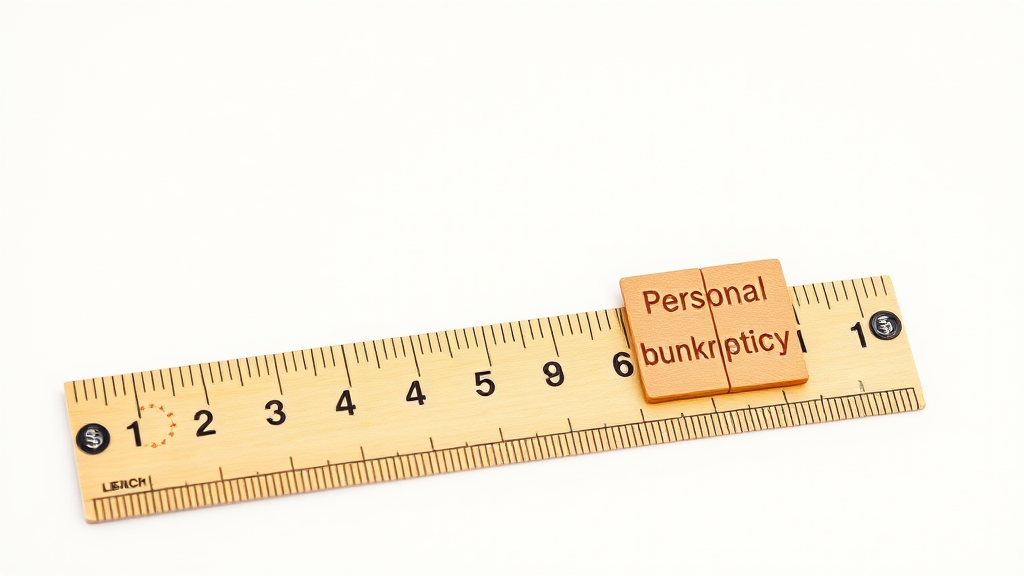Length of Time
How Long For A Personal Bankruptcy To Finish
bankruptcy, length of time
A first-time personal bankruptcy in Canada typically lasts nine months but can extend to 21 months if surplus income is involved. Surplus income is a government-set threshold that, if exceeded, lengthens the bankruptcy period. Repeat bankruptcies last longer and can have a notable impact on credit reports. Financial rehabilitation, including mandatory credit counseling, is crucial for successful recovery.

Article: Length of Personal Bankruptcy
Initial Bankruptcy Period
Standard duration for a first-time bankruptcy is nine months., Under what conditions the period can extend to 21 months., Obligations and compliance during this period.
In Canada, the standard duration for a first-time bankruptcy is nine months, offering a relatively quick route to debt relief for many. However, this period can extend to up to 21 months under certain conditions. For instance, if you have excess income beyond the limit established by the government, you're required to contribute a portion of this income to your creditors for the duration of your bankruptcy. If you're unable to fulfill this obligation, the bankruptcy extends to 21 months, ensuring that you contribute your fair share towards repaying your debts.
During the bankruptcy period, there are specific obligations and compliance requirements to meet. You’ll need to attend two mandatory credit counseling sessions, which aim to help you understand the causes of your financial troubles and to develop better financial management skills for the future. Monthly income and expense reports must also be submitted to your trustee, who monitors your financial activity closely to ensure compliance with the terms of your bankruptcy.
Let’s imagine you missed a couple of these credit counseling sessions or failed to submit your monthly reports on time. Such non-compliance could lead to delays in your discharge, further prolonging the bankruptcy process. Therefore, staying on top of these requirements is crucial to completing your bankruptcy as swiftly as possible. By meeting all your obligations and fully cooperating with your trustee, you stand a better chance of emerging from the bankruptcy period ready to rebuild your financial life.
Impact of Income on Bankruptcy Length
Definition and assessment of surplus income., How surplus income affects the length of bankruptcy., Examples to illustrate calculation and impact.
Surplus income plays a crucial role in determining the length of your bankruptcy in Canada. Defined by the government, surplus income is your monthly income exceeding what is deemed necessary for a reasonable standard of living, based on guidelines set by the Superintendent of Bankruptcy. This assessment considers household size and income, ensuring the calculations are fair for each individual or family. For example, if your net income surpasses the set threshold for your household size, you’re expected to make additional payments to your bankruptcy estate.
Now, how does this surplus income affect the length of your bankruptcy? If you have no surplus income, your bankruptcy could end in as few as nine months for a first-time filer. However, if surplus income is identified, the bankruptcy period is extended to 21 months to allow more time for the repayments. This extension ensures that creditors receive a fair portion of your surplus funds. So, the more you earn above the guideline, the longer your bankruptcy period could be, driving the importance of accurate income reporting and understanding these guidelines.
Let’s put this into perspective with a simple example. Imagine a single person earning $3,000 per month. According to the 2023 surplus income threshold, the allowed monthly income is $2,355. This individual would have a surplus income of $645 ($3,000 - $2,355). Half of this surplus, $322.50, must be paid to the bankruptcy estate each month. With this surplus, their bankruptcy will last for 21 months instead of the usual nine. Understanding and managing your surplus income can significantly impact your bankruptcy journey, highlighting the need for expert advice to navigate these waters effectively.
Elimiate up to 80% of Your Debt
High cost of gas, high cost of groceries, high lending rates, low salary - being in debt is not your fault! See if you qualify for government debt programs and get out of debt today!
Repeat Bankruptcies
Durations for second and subsequent bankruptcies., Surplus income impact on repeat bankruptcies., Statistics on the incidence of repeat bankruptcies.
When filing for a second or subsequent bankruptcy in Canada, the timeline changes significantly compared to a first bankruptcy. While the first bankruptcy typically lasts about nine months, a second bankruptcy extends to 24 months if there is no surplus income and 36 months if there is. For any subsequent bankruptcies, you’re looking at a minimum of 36 months without surplus income, but this period can stretch further depending on the circumstances and decisions by the court. Imagine going through the process three times; it's not just emotionally exhausting, but also significantly longer each time.
Surplus income can be a game-changer in the duration of your bankruptcy process. If you earn above a certain threshold, a portion of that income is considered surplus and must be paid to your creditors, which can elongate the bankruptcy period. For someone filing for a second bankruptcy, having surplus income means your bankruptcy could extend to 36 months instead of 24. The impact this has can’t be overstated. You’ll be budgeting and making payments for an extended period, which can be quite a journey to navigate.
Statistics reveal a sobering picture about repeat bankruptcies in Canada. Data shows that one in four people who file for bankruptcy are doing so for the second time or more. This isn’t just a number—it represents many Canadians struggling to stay afloat financially. For example, John, a 45-year-old from Toronto, found himself filing for bankruptcy for the third time due to unforeseen medical expenses. Understanding these statistics helps illustrate the persistent challenges many face, emphasizing the importance of tailored debt relief solutions and effective financial education.

Understanding the bankruptcy process and its length of time.
Impact on Credit Report
Timeframe personal bankruptcy stays on a credit report., Differences between first-time and repeat bankruptcies on credit reports., Real-world impacts on individual’s financial options post-bankruptcy.
In Canada, personal bankruptcy can loom large on your credit report for quite some time. For first-time bankruptcies, it typically stays on your record for six years after discharge. So, if you wrap up your bankruptcy today, expect it to show up on your credit report for the better part of a decade. However, this timeframe can increase dramatically for repeat bankruptcies. A second bankruptcy remains on your credit report for a staggering 14 years following discharge. This prolonged visibility can be a significant factor to consider if you’re contemplating filing for bankruptcy again.
The impact of bankruptcy on your credit report isn’t just about numbers and dates; it can have very tangible consequences on your daily life and financial decisions. Let’s put it this way: once you’ve declared bankruptcy, you’ll likely find that obtaining new credit becomes more difficult and more expensive. You might end up with higher interest rates and stricter repayment terms if approved for a loan at all. For instance, your dream of owning a home could be put on hold as you’ll probably need to wait until the bankruptcy is expunged from your record to qualify for any decent mortgage rates.
These real-world impacts don’t stop there. Your credit score could plunge, making basic things like renting an apartment or signing up for a mobile phone contract more challenging. Employers in industries like finance, where they might check your credit report, could consider your financial history a mark against you. However, it’s not all doom and gloom. With responsible financial behavior post-bankruptcy, such as timely bill payments and prudent use of any credit you might secure, you can slowly but surely rebuild your creditworthiness. Remember, it’s a journey, not a sprint.
Financial Rehabilitation and Education
Mandatory credit counselling sessions during bankruptcy., Goals and outcomes of financial education sessions., Successful rehabilitation stories and case studies.
Mandatory credit counselling sessions during bankruptcy serve as an essential step in the financial rehabilitation process for many Canadians. These sessions are designed to provide individuals with the tools and knowledge they need to manage their finances more effectively and avoid future insolvencies. For instance, imagine a family overwhelmed by their accumulated debt—they attend mandatory credit counselling and learn budgeting strategies, debt management techniques, and how to prioritize their expenses. As a result, they gain a clearer understanding of their financial situation and a realistic plan to move forward.
The goals and outcomes of financial education sessions are vast. Primarily, these sessions aim to empower individuals by enhancing their financial literacy. Through these sessions, participants learn to create effective budgets, understand credit scores, and plan for emergencies. One common goal is to help individuals make informed financial decisions to prevent future debt issues. Moreover, these sessions often result in improved financial habits. For example, after an educational session, many people report increased savings, better debt management, and a proactive approach to financial planning which fosters long-term stability and independence.
Successful rehabilitation stories and case studies highlight the transformative power of these financial education and credit counselling sessions. Take the story of John from Toronto, who, after filing for bankruptcy, attended his mandatory credit counselling sessions. John learned how to track his spending meticulously and trim unnecessary expenses. He also developed a realistic repayment plan for his remaining debts. Within two years, John managed to rebuild his credit score and even saved a small emergency fund. His journey from financial distress to stability underscores the importance of these sessions and serves as a testament to the potential for financial recovery with the right guidance and education.
References
| Title, Source |
|---|
| Bankruptcy in Canada: How the Process Works, Office of the Superintendent of Bankruptcy Canada |
| Understanding Surplus Income: How It Affects Bankruptcy, Hoyes, Michalos & Associates Inc. |
| The Impact of Bankruptcy on Your Credit Report, Equifax Canada |
| Repeat Bankruptcy: What You Need to Know, BDO Canada Limited |
| Mandatory Counselling Session, Grant Thornton Canada |
This article references information from the above sources.
Elimiate up to 80% of Your Debt
High cost of gas, high cost of groceries, high lending rates, low salary - being in debt is not your fault! See if you qualify for government debt programs and get out of debt today!